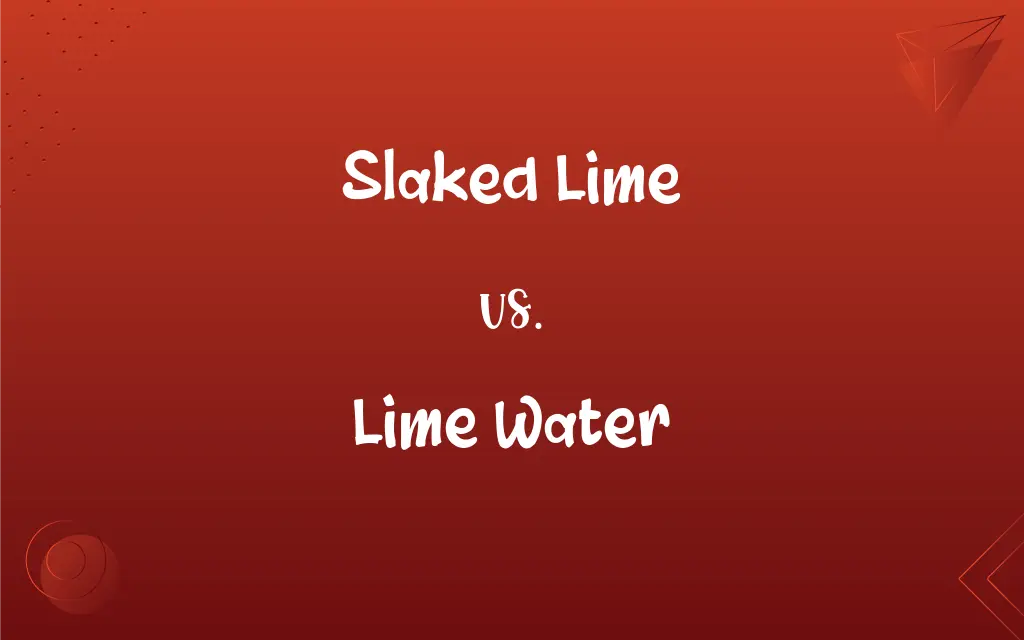Slaked Lime vs. Lime Water: What's the Difference?
Edited by Aimie Carlson || By Janet White || Published on January 15, 2024
Slaked lime is calcium hydroxide powder formed by adding water to quicklime, while lime water is a clear, saturated solution of slaked lime in water.

Key Differences
Slaked lime, chemically known as calcium hydroxide, is created by adding water to quicklime (calcium oxide). This exothermic reaction produces a fine powder used in various applications, from construction to agriculture. Lime water, on the other hand, is made by dissolving slaked lime in water, resulting in a clear, saturated solution. It is used in culinary, laboratory, and environmental applications.
In terms of composition, slaked lime is a dry, powdery substance that retains its basic chemical structure of calcium hydroxide. It can react with carbon dioxide in the air, forming calcium carbonate. Lime water, being a solution, has a portion of slaked lime dissolved in water and is often less reactive with air compared to its powdered form.
The uses of slaked lime include making mortar and plaster in construction, neutralizing acidic soil in agriculture, and treating water. Its high pH makes it suitable for these applications. Lime water is commonly used as a test for carbon dioxide, as it turns milky when exposed to it, and is used in cooking, especially in traditional recipes that require a crisp texture in vegetables or corn.
Safety measures for handling slaked lime are crucial due to its caustic nature, which can cause skin and respiratory irritation. It must be stored in airtight containers to prevent reaction with carbon dioxide. Lime water, being a diluted form, is less hazardous but still requires careful handling, particularly in culinary settings.
The physical properties of slaked lime include its ability to absorb moisture from the air, necessitating careful storage. Lime water, if left exposed, can lead to the precipitation of calcium carbonate, demonstrating its capacity to react with atmospheric carbon dioxide.
ADVERTISEMENT
Comparison Chart
Composition
Dry, powdery substance
Clear, saturated solution in water
Formation
Produced by adding water to quicklime
Made by dissolving slaked lime in water
Primary Uses
Construction, agriculture, water treatment
Culinary, laboratory testing, environmental
Safety and Handling
Caustic, requires careful storage
Less hazardous, requires careful handling
Reaction with Carbon Dioxide
Forms calcium carbonate with air exposure
Turns milky in presence of carbon dioxide
ADVERTISEMENT
Slaked Lime and Lime Water Definitions
Slaked Lime
Slaked lime can absorb moisture and carbon dioxide from the air.
The slaked lime was stored in airtight containers to prevent it from hardening.
Lime Water
Lime water can precipitate calcium carbonate over time.
The lime water left uncovered showed signs of calcium carbonate formation.
Slaked Lime
Slaked lime is calcium hydroxide, used in making mortar and plaster.
They used slaked lime in the construction of traditional houses.
Lime Water
It's a less concentrated form of calcium hydroxide.
Lime water was used instead of slaked lime for its milder effect.
Slaked Lime
Slaked lime is used to neutralize acidic soil in agriculture.
Farmers spread slaked lime on their fields to improve soil pH.
Lime Water
Lime water is a clear solution of slaked lime in water.
In the experiment, lime water turned milky upon exposure to carbon dioxide.
Slaked Lime
It's produced by adding water to quicklime.
When water was added to quicklime, slaked lime was formed.
Lime Water
It's used as a test for the presence of carbon dioxide in labs.
To detect carbon dioxide, scientists bubbled the gas through lime water.
Slaked Lime
It serves as a water treatment agent due to its alkaline properties.
Slaked lime was added to the water supply to purify it.
Lime Water
Lime water is used in cooking to crisp vegetables and corn.
She soaked the corn in lime water to make it crispier.
FAQs
What is slaked lime?
A powdery calcium hydroxide produced by hydrating quicklime.
What is lime water?
A saturated solution of slaked lime in water.
Can slaked lime be used in agriculture?
Yes, for soil neutralization and improvement.
How is slaked lime made?
By adding water to quicklime (calcium oxide).
Is lime water used in laboratories?
Yes, to test for the presence of carbon dioxide.
What are the safety measures for handling slaked lime?
Avoid skin and eye contact and inhalation; store in airtight containers.
How do you make lime water?
By dissolving slaked lime in water.
What happens when slaked lime is exposed to air?
It can absorb moisture and carbon dioxide, forming calcium carbonate.
Can lime water react with carbon dioxide?
Yes, it turns milky due to the formation of calcium carbonate.
Can slaked lime be harmful if ingested?
Yes, it's caustic and can cause internal burns.
What's the use of lime water in cooking?
To crisp vegetables and process corn.
Why is lime water used in carbon dioxide detection?
Because it visibly reacts by turning milky.
Is slaked lime the same as quicklime?
No, slaked lime is hydrated quicklime.
Is slaked lime used in water treatment?
Yes, for purifying and adjusting pH levels.
Does slaked lime have a shelf life?
Yes, it can harden or lose effectiveness over time.
Can lime water be used in environmental applications?
Yes, in water treatment and environmental testing.
What's the difference in pH between slaked lime and lime water?
Slaked lime has a higher pH due to its concentration.
How do you store lime water?
In a sealed container, away from direct sunlight and heat.
Can both slaked lime and lime water be used in construction?
Slaked lime is commonly used in construction, while lime water is not.
Is lime water safe to consume?
In small, diluted amounts, it can be, but caution is advised.
About Author
Written by
Janet WhiteJanet White has been an esteemed writer and blogger for Difference Wiki. Holding a Master's degree in Science and Medical Journalism from the prestigious Boston University, she has consistently demonstrated her expertise and passion for her field. When she's not immersed in her work, Janet relishes her time exercising, delving into a good book, and cherishing moments with friends and family.
Edited by
Aimie CarlsonAimie Carlson, holding a master's degree in English literature, is a fervent English language enthusiast. She lends her writing talents to Difference Wiki, a prominent website that specializes in comparisons, offering readers insightful analyses that both captivate and inform.

































































